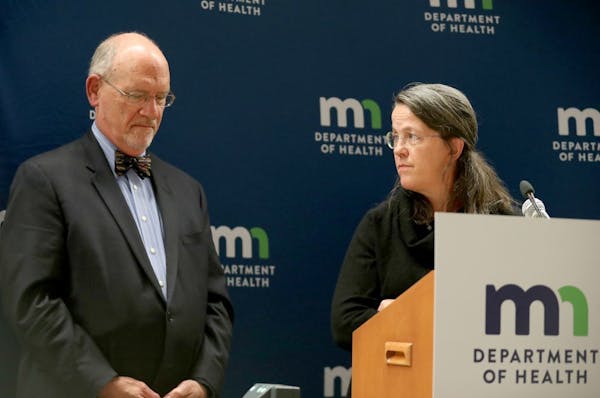With the opioid epidemic sweeping through parts of Minneapolis, police officers on the city's hard-hit South Side will soon start carrying the overdose-reversing drug, naloxone.
Initially, officials say that 125 officers from the 3rd Precinct will be equipped with the lifesaving kits, as part of a pilot program that was first announced last fall. But Mayor Jacob Frey pledged to outfit the rest of the department's officers by the end of the year.
"This opioid epidemic is tearing families apart," said Frey, speaking to reporters at a joint news conference with police Chief Medaria Arradondo on Monday morning at the American Indian Center. Standing before an array of TV cameras, Frey said that "more than half of the people watching" know someone who has died of a drug overdose.
"We will be equipping every officer with naloxone by year's end," Frey said, adding that the kits cost about $75 per officer. He said that the rollout was part of a push by the department and his administration to combat overdoses across the city that would go beyond the "traditional sobriety treatment" model, but didn't offer specifics.
"It's not just Narcan, it's not just naloxone," he said. He pointed out that last fall Minneapolis joined a wave of cities and counties nationally in suing pharmaceutical companies for the public cost of the opioid crisis.
First responders rely on naloxone, known commonly as Narcan, to quickly counteract the effects of an opioid overdose, by blocking opiate receptors in the body and reversing the slow breathing that can cause death.
A recent surge of overdoses in the city has put officials on high alert.
Arradondo said it was no coincidence that the drug is being rolled out first in the South Side precinct, which has seen about a quarter of all overdoses citywide. Local officials say the area's black and American Indian populations have been the hardest hit.
So far this year, police have responded to 208 overdose-related emergency calls, according to department data released Monday.
Of those, 49 calls originated in the 3rd Precinct, which encompasses the southern portion of the city, with most clustered in an area north of E. Lake Street. Arradondo said he was unsure of why overdoses appeared to be clustered in certain neighborhoods, most notably Phillips.
If the citywide pace holds, 2018 would end with more than three times as many such calls as either of the previous two years, when officers responded to about 250 overdose reports each year.
Arradondo said that the department's new approach emphasizes treatment rather than enforcement.
"Their first and primary responsibility is to save lives," he said of his officers. "How they got the drugs ... is secondary."
The department also plans to train civilian staff in its property and evidence section, who may come in contact with opioids.
Later Monday, officers, including several supervisors, were instructed on how to spot signs of overdose — slowed or nonexistent breathing, blue lips, "pinpoint" pupils and unresponsiveness — and how to assemble the 2-millileter syringes found in each kit, which in combination with an atomizer, are sprayed into the victim's nose.
Officials said the plan calls for the remaining officers to be trained over the next two weeks.
More than 64,000 people died of a drug overdose in 2016, according to the National Center for Health Statistics, more than those killed in car accidents or by gun violence.
While Upper Midwest states such as Minnesota have largely been spared the devastating overdose rates seen on the East Coast, the epidemic — exacerbated recently by the spread of dangerously potent synthetic opioids like fentanyl and carfentanil — has been creeping westward, officials say.
Last year, about 68 percent of law enforcement agencies across the country carried naloxone, compared to only 4 percent in 2014, department statistics show. For years, department officials resisted calls to outfit their officers with the lifesaving drug, arguing that firefighters and paramedics were often the first ones on the scene of an overdose.
But that changed with the recent surge in opioid overdoses.
Paramedics also have seen a spike in overdose calls. Mike Trullinger, deputy chief of operations for Hennepin EMS, said that paramedics have administered naloxone close to 400 times to treat people stricken by suspected overdoses through the first three months of the year — putting them on track to exceed the roughly 1,000 doses given last year.
"Now, we're giving larger amounts to give the same effects because of the potency of the illicit drugs that people take," Trullinger said.
He wondered whether the timing of the department's naloxone rollout had something to do with the growing practice of mixing synthetic opioids with other drugs, prompting law enforcement across the country to warn their officers that even the smallest exposure such homemade concoctions can prove deadly.
Libor Jany • 612-673-4064 Twitter:@StribJany

Meet the Athena winners: 103 girl athletes picked by their schools

A tale of 124 hoarded Minnesota cats has at least a hundred happy endings

Walz, St. Paul leaders urge support for copper wire theft bill: 'We've got to get in front of it'
Body of missing canoeist, 15, recovered from southwest Minnesota lake

